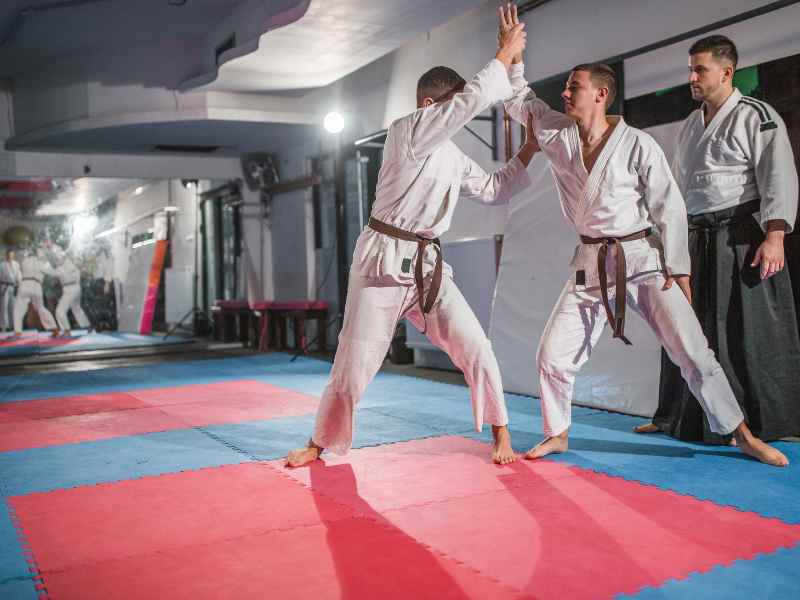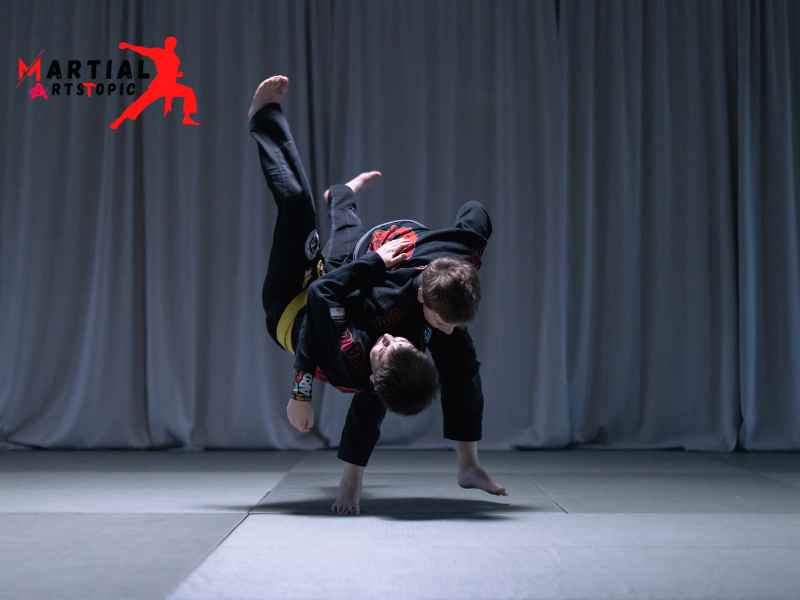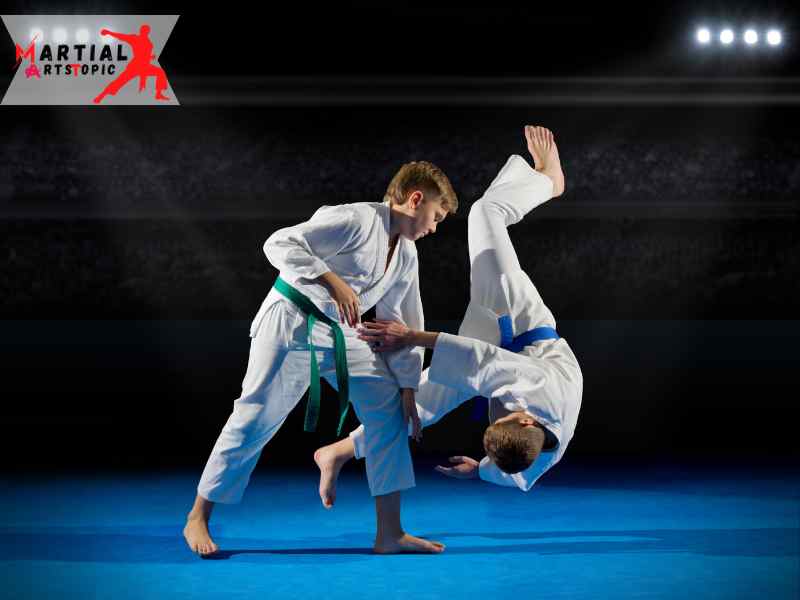
History and Origins of Daito-ryu Aiki-jujutsu
Daito-ryu Aiki-jujutsu stands out as a powerful and intricate fighting style. This ancient Japanese martial art has a rich history and fascinating origins that have captivated martial arts enthusiasts for centuries. The depths of Daito-ryu Aiki-jujutsu, exploring its historical roots and shedding light on its development over time.
Daito-ryu Aiki-jujutsu, often referred to simply as Daito-ryu, traces its origins back to the 9th century in Japan. Shinra Saburo Minamoto no Yoshimitsu, who was a member of the influential Minamoto clan found it. Yoshimitsu was a master martial artist and military strategist, and he sought to create a combat system that would be effective in real-life combat situations.
The art of Daito-ryu Aiki-jujutsu is deeply rooted in the principles of aiki, which refers to the harmonization of energy and the ability to blend with an opponent’s movements. This concept of aiki sets Daito-ryu apart from other jujutsu styles, as it emphasizes the importance of redirecting an attacker’s energy rather than meeting force with force.
Throughout its history, Daito-ryu Aiki-jujutsu has been passed down through generations, with each successive master adding their own unique insights and techniques to the system. One of the most influential figures in the development of Daito-ryu was Sokaku Takeda, who lived during the late 19th and early 20th centuries. Takeda, a formidable martial artist and teacher, played a crucial role in spreading the art and refining its techniques.
In the early 20th century, one of Takeda’s most notable students, Morihei Ueshiba, went on to found his own martial art called Aikido. Ueshiba’s Aikido was heavily influenced by Daito-ryu Aiki-jujutsu, and many of the techniques and principles of Daito-ryu can be found in Aikido.
Today, Daito-ryu Aiki-jujutsu continues to be practiced and taught by dedicated practitioners around the world. We know its techniques for their effectiveness in close-quarters combat, utilizing joint locks, throws, and immobilization techniques to subdue opponents. The emphasis on aiki and blending makes Daito-ryu a unique and highly practical martial art.
In recent years, Daito-ryu Aiki-jujutsu has gained increased recognition and popularity, thanks in part to the efforts of various organizations and instructors dedicated to preserving and promoting the art. Numerous seminars, workshops, and training camps are held worldwide to provide enthusiasts with the opportunity to learn and train in this ancient martial art.
The Role of Daito-ryu Aiki-jujutsu in Modern Martial Arts

Daito-ryu Aiki-jujutsu holds a significant place in the landscape of modern martial arts. Rooted in ancient Japanese traditions, this martial art emphasizes the principles of harmony, fluidity, and efficient use of energy. Its techniques focus on joint locks, throws, and controlling an opponent through subtle movements and redirection of force. Many modern martial arts, including aikido and judo, have been influenced by Daito-ryu Aiki-jujutsu. Its emphasis on blending with an opponent’s energy rather than meeting force with force continues to inspire practitioners to cultivate a deeper understanding of martial arts and self-defense. The principles and techniques of Daito-ryu Aiki-jujutsu offer valuable insights for practitioners seeking to hone their skills and deepen their understanding of martial arts.
Daito-ryu Aiki-jujutsu: Essential Techniques and Training Tips
Daito-ryu Aiki-jujutsu is a martial art that combines powerful techniques with the principles of Aiki, making it a formidable self-defense system. With a rich history dating back centuries, Daito-ryu Aiki-jujutsu has been passed down through generations, refining its techniques and strategies along the way.
Understanding Daito-ryu Aiki-jujutsu
Daito-ryu Aiki-jujutsu is based on the concept of Aiki, which involves blending with an opponent’s energy and redirecting it to gain control. This martial art focuses on joint locks, throws, and immobilization techniques, making it highly effective in close-quarters combat. By understanding the principles of Aiki, practitioners can neutralize and subdue opponents of any size.
Essential Techniques
- Joint Locks: Daito-ryu Aiki-jujutsu emphasizes the use of joint locks to control an opponent’s movement. By applying precise pressure on specific joints, practitioners can immobilize an attacker, rendering them unable to continue their assault.
- Throws: Throws are an integral part of Daito-ryu Aiki-jujutsu. These techniques involve using an opponent’s momentum against them, redirecting their energy to throw them off balance and onto the ground. Proper timing and body positioning are crucial for executing throws effectively.
- Immobilization Techniques: Daito-ryu Aiki-jujutsu includes various immobilization techniques that allow practitioners to control and restrain opponents. These techniques involve applying pressure to specific points on an opponent’s body, resulting in pain compliance or complete immobilization.
Training Tips
- Focus on Fundamentals: Mastering Daito-ryu Aiki-jujutsu requires a solid foundation in the fundamental techniques. Spend ample time perfecting your joint locks, throws, and immobilization techniques. Pay attention to details such as footwork, body positioning, and timing to ensure maximum effectiveness.
- Practice with a Partner: Daito-ryu Aiki-jujutsu is best learned through hands-on training with a partner. Regularly practice techniques with a training partner to develop your reflexes, timing, and sensitivity to an opponent’s movements.
- Study Under a Qualified Instructor: Finding a qualified instructor is key to mastering Daito-ryu Aiki-jujutsu. Look for an instructor with extensive experience and a lineage traceable back to the art’s founder. A skilled instructor can provide guidance, correct your technique, and facilitate your progress.
- Train Mindfully: Daito-ryu Aiki-jujutsu requires a balance of physical and mental training. Cultivate a focused and calm mindset during training sessions, as it will enhance your ability to apply techniques effectively under pressure.
- Cross-train for Versatility: To further enhance your skills in Daito-ryu Aiki-jujutsu, consider cross-training in other martial arts. This can broaden your understanding of different fighting styles, improve your adaptability, and provide additional tools for self-defense.
The philosophy and principles behind Daito-ryu Aiki-jujutsu
Daito-ryu Aiki-jujutsu is a traditional Japanese martial art that encompasses profound philosophy and intricate principles. Rooted in centuries of history, this martial art focuses not only on physical techniques but also on the cultivation of inner strength and harmony. In this blog post, we delve into the essence of Daito-ryu Aiki-jujutsu, exploring its philosophy and the fundamental principles that guide its practitioners.
The Philosophy of Daito-ryu Aiki-jujutsu

At the core of Daito-ryu Aiki-jujutsu lies the principle of aiki, which can be understood as the harmonization of energy. Aiki is not merely a physical concept but a way of life, promoting the balance between mind, body, and spirit. It teaches practitioners to blend and redirect their opponent’s energy, rather than oppose it directly. This philosophy emphasizes the importance of efficiency, fluidity, and non-resistance in combat situations.
Daito-ryu Aiki-jujutsu embraces the concept of ju, meaning softness or gentleness. Contrary to popular belief, ju does not imply weakness but represents adaptability and flexibility. By harnessing the power of ju, practitioners can overcome stronger opponents by using their own force against them. This philosophy teaches humility, patience, and the ability to yield when necessary.
Key Principles of Daito-ryu Aiki-jujutsu
To embody the philosophy of Daito-ryu Aiki-jujutsu, practitioners adhere to a set of fundamental principles. These principles serve as a roadmap, guiding their actions both on and off the mat. Let’s explore some of these principles:
- Kuzushi (Off-Balancing): Daito-ryu Aiki-jujutsu places great emphasis on disrupting an opponent’s balance. By using precise movements and leverage, practitioners aim to unbalance their adversaries, creating opportunities for effective techniques.
- Aiki (Harmony): As mentioned earlier, aiki is the cornerstone of Daito-ryu Aiki-jujutsu. Practitioners strive to blend with their opponent’s movements, harmonizing their energy to maintain control and execute techniques effortlessly.
- Ma-ai (Combative Distance): Understanding the concept of ma-ai is crucial in Daito-ryu Aiki-jujutsu. It refers to the optimal distance between oneself and the opponent, enabling effective timing and control. By mastering ma-ai, practitioners can neutralize attacks and create openings for counter-techniques.
- Zanshin (Awareness): Zanshin, translated as “remaining mind,” is the state of heightened awareness before, during, and after a technique. They train practitioners to maintain a mental presence, ensuring they are fully prepared to respond to any situation.
- Mushin (No-Mind): Mushin is a state of mind where thoughts and emotions are set aside, allowing spontaneous action. In Daito-ryu Aiki-jujutsu, practitioners aim to cultivate muslin, enabling them to respond to unpredictable situations with clarity and focus.
The Benefits of Practicing Daito-ryu Aiki-jujutsu
Daito-ryu Aiki-jujutsu is a traditional Japanese martial art that focuses on self-defense techniques utilizing joint locks, throws, and strikes. It is a comprehensive system that emphasizes the importance of blending with an opponent’s energy and redirecting it to gain control. As one of the most authentic and effective martial arts, Daito-ryu Aiki-jujutsu offers numerous benefits to its practitioners. In this blog post, we will explore the advantages of training in Daito-ryu Aiki-jujutsu and why it has gained popularity worldwide.
Physical Fitness and Strength
One of the primary benefits of practicing Daito-ryu Aiki-jujutsu is the improvement in physical fitness and strength. The techniques involved in this martial art require the use of all major muscle groups in the body, resulting in increased overall strength and endurance. Regular training in Daito-ryu Aiki-jujutsu can help develop core stability, flexibility, and cardiovascular fitness. By engaging in dynamic movements and challenging drills, practitioners can improve their agility, coordination, and reaction time.
Self-Defense Skills
Daito-ryu Aiki-jujutsu is highly regarded for its practicality and effectiveness in real-life self-defense situations. The techniques taught in this martial art focus on exploiting an opponent’s weaknesses and utilizing their energy against them. By mastering joint locks, throws, and strikes, practitioners can effectively neutralize threats from larger and stronger opponents. Daito-ryu Aiki-jujutsu provides the knowledge and skills necessary to protect oneself and others in various confrontational scenarios.
Mental Discipline and Focus
In addition to physical benefits, Daito-ryu Aiki-jujutsu promotes mental discipline and focus. Training in this martial art requires concentration, mental clarity, and the ability to make split-second decisions. By practicing techniques and engaging in partner drills, practitioners develop a heightened sense of awareness and focus. This mental discipline cultivated through Daito-ryu Aiki-jujutsu training can be applied to other areas of life, such as work, academics, and personal relationships.
Stress Relief and Emotional Well-being
Engaging in Daito-ryu Aiki-jujutsu training can significantly reduce stress levels and improve emotional well-being. The intense physical activity involved in this martial art releases endorphins, which are natural mood enhancers. Regular practice provides an outlet for stress and negative emotions, allowing practitioners to channel their energy in a constructive manner. Daito-ryu Aiki-jujutsu also promotes self-confidence and self-esteem, empowering practitioners to face challenges with a positive mindset.
Cultural Understanding and Personal Growth
Daito-ryu Aiki-jujutsu is deeply rooted in Japanese history and culture. Training in this martial art provides an opportunity to gain a deeper understanding of traditional Japanese values, etiquette, and philosophy. It fosters a sense of respect, discipline, and humility, which are essential qualities for personal growth. Practitioners of Daito-ryu Aiki-jujutsu often develop a strong connection with their training partners and the martial art community, creating a supportive and inclusive environment.
Rank System and Progression in Daito-ryu Aiki-jujutsu
Daito-ryu Aiki-jujutsu is a traditional Japanese martial art that has gained recognition for its effective techniques and an emphasis on blending with an opponent’s movements. As practitioners delve deeper into this ancient martial art, they discover a structured rank system and progression that serves as a roadmap on their journey towards mastery.
The Rank System in Daito-ryu Aiki-jujutsu
The rank system in Daito-ryu Aiki-jujutsu provides a framework for students to gauge their progress and development within the art. It consists of various levels, with each rank denoting a practitioner’s understanding, skill, and dedication to the art. The system typically incorporates colored belts or other insignias to indicate rank, making it easy for practitioners and instructors alike to identify their current position in the learning process.
Progression and Advancement
Advancement through the rank system in Daito-ryu Aiki-jujutsu is not solely based on technical proficiency, but also on the cultivation of the art’s underlying principles and philosophy. As practitioners train and refine their techniques, they simultaneously focus on developing their understanding of timing, distance, balance, and the application of aiki (blending) with their opponents. This holistic approach ensures that students not only gain physical prowess, but also deepen their understanding of the art’s core principles.
The Role of Competence and Knowledge
In Daito-ryu Aiki-jujutsu, someone closely linked rank advancement to a practitioner’s competence and knowledge. As students progress from one rank to another, we expected them to demonstrate proficiency in a wide range of techniques, including throws, joint locks, strikes, and pins. Additionally, they must display an understanding of the underlying principles that govern these techniques, such as proper body mechanics, timing, and the ability to read an opponent’s movements.
Mentorship and Guidance
Throughout their journey, Daito-ryu Aiki-jujutsu practitioners benefit from the guidance and mentorship of experienced instructors. These mentors play a vital role in evaluating a student’s progress, providing feedback, and guiding them towards the next stage of their development. Their expertise and insight help students navigate the complexities of the art, ensuring that they progress steadily and effectively through the ranks.
The Importance of Patience and Perseverance
The rank system in Daito-ryu Aiki-jujutsu underscores the importance of patience and perseverance. Advancement through the ranks is not an overnight accomplishment but rather a result of years of dedicated practice and commitment to continuous improvement. It is through this journey that practitioners cultivate discipline, resilience, and a deeper understanding of themselves, further enhancing their skills as martial artists.
In conclusion
Daito-ryu Aiki-jujutsu is a fascinating martial art with deep roots in Japanese history. Its emphasis on fluid and efficient movements, combined with the utilization of joint locks and throws, makes it a highly effective self-defense system. The principles of aiki, which involve blending with the opponent’s energy and redirecting it, serve as the foundation for Daito-ryu’s techniques.Throughout its evolution, Daito-ryu Aiki-jujutsu has influenced various other martial arts, including aikido. They have passed its techniques and training methods down through generations, ensuring the preservation and continued practice of this valuable martial art.
Whether one is seeking practical self-defense skills, physical fitness, or a deeper understanding of martial arts principles, Daito-ryu Aiki-jujutsu offers a comprehensive approach. With its rich history and effective techniques, it continues to captivate and inspire practitioners around the world.
